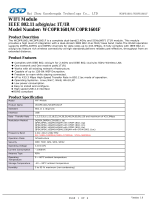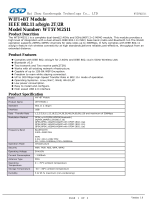
Philips North America LLC
Philips Healthcare, 3000 Minuteman Road, Andover, MA 01810, United States
www.philips.com/healthcare
Phone: +1 (888) 744 5477 – Fax: +1 (978) 659 7561
Page 1 of 4
04-Dec-19
Philips PHC-11AC1-A Wi-Fi/BT Module
User’s Manual
Product: PHC-11AC1-A Wi-Fi/BT Module
Model: PHC-11AC1-A
FCC ID: 2ATC9-PHC-11AC1
IC: 25528- PHC11AC1
For OEM integration only – device cannot be sold to general public. Therefore we will not supply a
User’s manual.
We will ask OEM to include the following Notices required by FCC/ IC on the product and in the User’s
manual.
FCC Rule Part FCC Part 15.247 (2.4 GHz radios), 15.407 (5 GHz)
IC Rule Part RSS-247
Notifications
FCC ID: 2ATC9-PHC-11AC1
IC: 25528- PHC11AC1
NOTICE
Federal Communication Interference Statement (United States only)
This equipment has been tested and found to comply with the limits for a class B digital device, pursuant
to Part 15 of the FCC rules. These limits are designed to provide reasonable protection against harmful
interference in a residential installation. This equipment generates, uses, and can radiate radio

Notifications
Page 2 of 4
04-Dec-19
frequency energy and, if not installed and used in accordance with the instructions, may cause harmful
interference to radio communications. However, there is no guarantee that interference will not occur
in a particular installation. If this equipment does cause harmful interference to radio or television
reception, which can be determined by turning the equipment off and on, the user is encouraged to try
to correct the interference by one or more of the following measures:
• Re-orient or relocate the receiving antenna
• Increase the separation between the equipment and receiver
• Connect the equipment to an outlet on a circuit different from that to which the receiver is
connected
• Consult the dealer or an experienced radio/TV technician for help
This device and its antenna(s) must not be co-located or operation in conjunction with any other
antenna or transmitter.
Per FCC 15.407(c), the device will automatically discontinue transmission in case of either absence of
information to transmit or operational failure. This is done via the device utilizing the 802.11 MAC
protocol in its communication with other modules. The 802.11 MAC provides for transmission only
when information is present to transmit. When there is no information to transmit, no packets will be
scheduled for transmission and the RF transmit circuitry will remain off. In the case that operational
failure is detected, the module will be rebooted and transmission will cease until the processor verifies
normal operation.
Canadian Department of Communications Industry Canada Notice (Canada only)
This Class B digital apparatus complies with Canadian ICES-003.
Cet appareil numérique de la classe B est conforme à la norme NMB-003 du Canada.
FCC Rules, Part 15.19 / Industry Canada
This device complies with Part 15 of FCC Rules and Industry Canada licence-exempt RSS standard(s).
Operation is subject to the following two conditions:
• This device may not cause harmful interference, and
• This device must accept any interference, including interference that may cause undesired
operation of this device.
Le présent appareil est conforme aux la partie 15 des règles de la FCC et CNR d'Industrie Canada
applicables aux appareils radio exempts de licence. L'exploitation est autorisée aux deux conditions
suivantes :
• l'appareil ne doit pas produire de brouillage, et
• l'utilisateur de l'appareil doit accepter tout brouillage radioélectrique subi, même si le
brouillage est susceptible d'en compromettre le fonctionnement.

Notifications
Page 3 of 4
04-Dec-19
This equipment complies with FCC/IC radiation exposure limits set forth for an uncontrolled
environment and meets the FCC radio frequency (RF) Exposure Guidelines in Supplement C to OET65
and RSS-102 of the IC radio frequency (RF) Exposure rules. This equipment should be installed and
operated keeping the radiator at least 20cm or more away from person’s body
Cet équipement est conforme aux limites d’exposition aux rayonnements énoncées pour un
environnement non contrôlé et respecte les règles les radioélectriques (RF) de la FCC lignes directrices
d'exposition dans le Supplément C à OET65 et d’exposition aux fréquences radioélectriques (RF) CNR-
102 de l’IC. Cet équipement doit être installé et utilisé en gardant une distance de 20 cm ou plus entre le
dispositif rayonnant et le corps.
Under Industry Canada regulations, this radio transmitter may only operate using an antenna of a type
and maximum (or lesser) gain approved for the transmitter by Industry Canada. To reduce potential
radio interference to other users, the antenna type and its gain should be so chosen that the equivalent
isotropically radiated power (e.i.r.p.) is not more than that necessary for successful communication.
Conformément à la réglementation d'Industrie Canada, le présent émetteur radio peut fonctionner avec
une antenne d'un type et d'un gain maximal (ou inférieur) approuvé pour l'émetteur par Industrie
Canada. Dans le but de réduire les risques de brouillage radioélectrique à l'intention des autres
utilisateurs, il faut choisir le type d'antenne et son gain de sorte que la puissance isotrope rayonnée
équivalente (p.i.r.e.) ne dépasse pas l'intensité nécessaire à l'établissement d'une communication
satisfaisante.
This radio transmitter 25528- PHC11AC1 has been approved by Industry Canada to operate with the
antenna types listed below with the maximum permissible gain and required antenna impedance for
each antenna type indicated. Antenna types not included in this list, having a gain greater than the
maximum gain indicated for that type, are strictly prohibited for use with this device.
Le présent émetteur radio 25528- PHC11AC1 a été approuvé par Industrie Canada pour fonctionner avec
les types d'antenne énumérés ci-dessous et ayant un gain admissible maximal et l'impédance requise
pour chaque type d'antenne. Les types d'antenne non inclus dans cette liste, ou dont le gain est
supérieur au gain maximal indiqué, sont strictement interdits pour l'exploitation de l'émetteur.
For product available in the USA/Canada market, only channel 1~11 can be operated at 2.4GHz. At this
frequency band, selection of other channels is not possible.
This device is going to be operated in 5.15~5.25GHz frequency range, it is restricted in indoor
environment only.
Frequency Tolerance:+/-20ppm
WARNING (Part 15.21):

Notifications
Page 4 of 4
04-Dec-19
The FCC / The Industry Canada regulations provide that changes or modifications not expressly
approved by the party responsible for compliance could void the user’s authority to operate the
equipment.
Manual and Product Labeling information To The End User
The end user manual shall include all required regulatory information/warning as show in this manual.
And when this module is installed in the host product, you must include a "Contains FCC ID: 2ATC9-PHC-
11AC1" and a “IC: 25528- PHC11AC1” in the labeling of the host product.
OEM Responsibilities to comply with FCC and Industry Canada Regulations
The PHC-11AC1-A Wi-Fi/BT Module has been certified for integration into Philips’ own products only by
Philips subsidiaries under the following conditions:
1. The antenna(s) must be installed such that a minimum separation distance of 20cm is maintained
between the radiator (antenna) and all persons at all times.
2. The transmitter module must not be co-located or operating in conjunction with any other antenna
or transmitter.
As long as the two conditions above are met, further transmitter testing will not be required. However,
the Philips integrator is still responsible for testing their end-product for any additional compliance
requirements required with this module installed (for example, digital device emissions, PC peripheral
requirements, etc.).
IMPORTANT NOTE: In the event that these conditions cannot be met (for certain configurations or
co-location with another transmitter), then the FCC and Industry Canada authorizations are no longer
considered valid and the FCC ID and IC Certification Number cannot be used on the final product. In
these circumstances, the Philips subsidiary will be responsible for re-evaluating the end product
(including the transmitter) and obtaining a separate FCC and Industry Canada authorization.
Information on test modes and additional testing requirements
Only Cypress Test SW utility shall be used to set the module to transmit continuously.
Additional Testing – Part 15 Subpart B Disclaimer
The module is only FCC authorized for the specific rule parts listed on the grant, and that the host
product manufacturer (Philips subsidiary/integrator) is responsible for compliance to any other FCC
rules that apply to the host not covered by the modular transmitter grant of certification. The final host
product still requires Part 15 Subpart B compliance testing with the modular transmitter installed.
-
 1
1
-
 2
2
-
 3
3
-
 4
4
Philips PHC-11AC1 Manuel utilisateur
- Taper
- Manuel utilisateur
- Ce manuel convient également à
dans d''autres langues
- English: Philips PHC-11AC1 User manual
Autres documents
-
Suzhou 360 Robotic Technology 360 S8 Series Robot Vacuum Cleaner Manuel utilisateur
-
Osram NINAB30 Manuel utilisateur
-
Lantronix Open-Q 865 Mode d'emploi
-
GSD DT3AR1501 Manuel utilisateur
-
 GSD WC0PR1601 Le manuel du propriétaire
GSD WC0PR1601 Le manuel du propriétaire
-
GSD WXT5BM2511 Le manuel du propriétaire
-
Lantronix Open-Q Mode d'emploi
-
Juniper SRX-MP-WLAN-US How To Install
-
Mediatek MT7922A22M Mode d'emploi
-
 Hui Zhou Gaoshengda Technology WT5YM2511 Wi-Fi+BT Module Mode d'emploi
Hui Zhou Gaoshengda Technology WT5YM2511 Wi-Fi+BT Module Mode d'emploi





